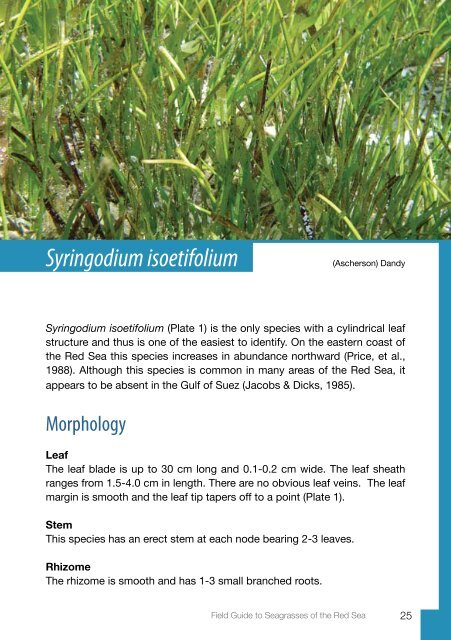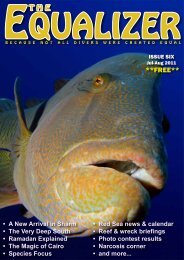Field Guide to Seagrasses of the Red Sea - Seagrass-Watch
Field Guide to Seagrasses of the Red Sea - Seagrass-Watch
Field Guide to Seagrasses of the Red Sea - Seagrass-Watch
Create successful ePaper yourself
Turn your PDF publications into a flip-book with our unique Google optimized e-Paper software.
Syringodium isoetifolium<br />
(Ascherson) Dandy<br />
Syringodium isoetifolium (Plate 1) is <strong>the</strong> only species with a cylindrical leaf<br />
structure and thus is one <strong>of</strong> <strong>the</strong> easiest <strong>to</strong> identify. On <strong>the</strong> eastern coast <strong>of</strong><br />
<strong>the</strong> <strong>Red</strong> <strong>Sea</strong> this species increases in abundance northward (Price, et al.,<br />
1988). Although this species is common in many areas <strong>of</strong> <strong>the</strong> <strong>Red</strong> <strong>Sea</strong>, it<br />
appears <strong>to</strong> be absent in <strong>the</strong> Gulf <strong>of</strong> Suez (Jacobs & Dicks, 1985).<br />
Morphology<br />
Leaf<br />
The leaf blade is up <strong>to</strong> 30 cm long and 0.1-0.2 cm wide. The leaf sheath<br />
ranges from 1.5-4.0 cm in length. There are no obvious leaf veins. The leaf<br />
margin is smooth and <strong>the</strong> leaf tip tapers <strong>of</strong>f <strong>to</strong> a point (Plate 1).<br />
Stem<br />
This species has an erect stem at each node bearing 2-3 leaves.<br />
Rhizome<br />
The rhizome is smooth and has 1-3 small branched roots.<br />
<strong>Field</strong> <strong>Guide</strong> <strong>to</strong> <strong><strong>Sea</strong>grasses</strong> <strong>of</strong> <strong>the</strong> <strong>Red</strong> <strong>Sea</strong> 25





